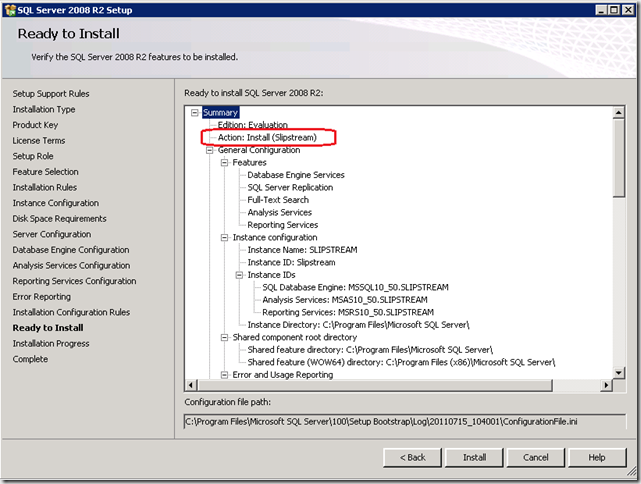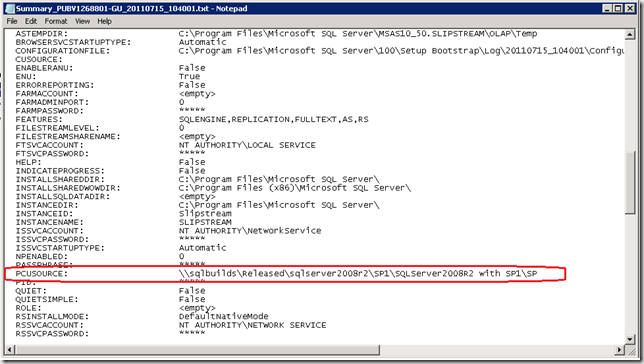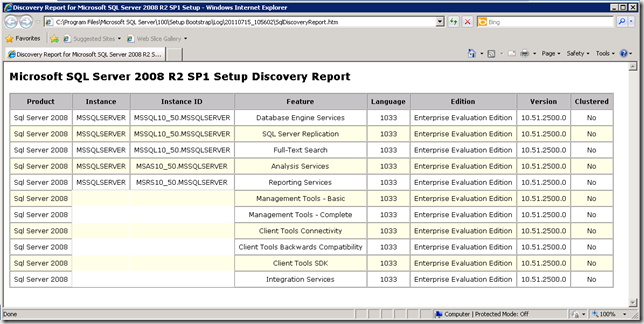How to slipstream SQL Server 2008 R2 and a SQL Server 2008 R2 Service Pack 1 (SP1)
With the release SQL Server 2008 R2 SP1, I have compiled the list of steps to create a slipstream drop. Once you have created this slipstream drop, you can install the original release of SQL Server 2008 R1 and SP1 at the same time. The slipstream functionality performs a single installs that is quicker when compared to installing the original release and then applying the service pack. Additionally this slipstream drop fixes any Setup issues that prevent a successful installation or upgrade that has been addressed in SP1. See this KB2528583 for a list on fixes in Service Pack 1. This slipstream drop is for new installation or upgrades,. To patch existing SQL Server 2008 features, download SP1 from the download center or obtain from Microsoft Update when available.
Here are the steps:
1. Copy your original SQL Server 2008 R2 source media to C:\SQLServer2008R2_SP1
2. Download the SQL Server 2008 R2 SP1 packages from here. You need to download all Service Pack 1 architecture packages:
- SQLServer2008R2SP1-KB2528583-IA64-ENU.exe
- SQLServer2008R2SP1-KB2528583-x64-ENU.exe
- SQLServer2008R2SP1-KB2528583-x86-ENU.exe
3. Extract each of the SQL Server 2008 SP1 packages to C:\SQLServer2008R2_SP1\SP as follows:
- SQLServer2008R2SP1-KB2528583-IA64-ENU.exe /x:C:\SQLServer2008R2_SP1\SP
- SQLServer2008R2SP1-KB2528583-x64-ENU.exe /x:C:\SQLServer2008R2_SP1\SP
- SQLServer2008R2SP1-KB2528583-x86-ENU.exe /x:C:\SQLServer2008R2_SP1\SP
Ensure you complete this step for all architectures to ensure the original media is updated correctly.
4. Copy Setup.exe from the SP extracted location to the original source media location. Here is the robocopy command:
- robocopy C:\SQLServer2008R2_SP1\SP C:\SQLServer2008R2_SP1 Setup.exe
6. Copy all files not the folders, except the Microsoft.SQL.Chainer.PackageData.dll, in C:\SQLServer2008R2_SP1\SP\<architecture> to C:\SQLServer2008R2_SP1\<architecture> to update the original files. Here is the robocopy command:
- robocopy C:\SQLServer2008R2_SP1\SP\x86 C:\SQLServer2008R2_SP1\x86 /XF Microsoft.SQL.Chainer.PackageData.dll
- robocopy C:\SQLServer2008R2_SP1\SP\x64 C:\SQLServer2008R2_SP1\x64 /XF Microsoft.SQL.Chainer.PackageData.dll
- robocopy C:\SQLServer2008R2_SP1\SP\ia64 C:\SQLServer2008R2_SP1\ia64 /XF Microsoft.SQL.Chainer.PackageData.dll
7. Determine if you have a DefaultSetup.INI at the following locations:
- C:\SQLServer2008R2_SP1\x86
- C:\SQLServer2008R2_SP1\x64
- C:\SQLServer2008R2_SP1\ia64
If you have a DefaultSetup.INI at the above locations, add the following lines to each DefaultSetup.INI:
PCUSOURCE=".\SP"
If you do NOT have a DefaultSetup.INI, create one with the following content:
;SQLSERVER2008 R2 Configuration File
[SQLSERVER2008]
PCUSOURCE=".\SP"
and copy to the following locations
-
- C:\SQLServer2008R2_SP1\x86
- C:\SQLServer2008R2_SP1\x64
- C:\SQLServer2008R2_SP1\ia64
This file will tell the setup program where to locate the SP source media that you previously extracted.
8. Run setup.exe as you normally would.
How can I tell I am slipstreaming:
1) You should see the "Update Setup Media Language Rule" on the Installation Rules dialog:
2) On the Ready to Install dialog, the Action will indicated (“Slipstream”):
3) You will see the PCUSource parameters specified in the Summary log:
4) Results from SQL Discovery Report launched from Installation Center (first CU for SP1)
Comments
Anonymous
July 14, 2011
I'm running Windows 7 Enterprise 64-bit BTW. wclark@guidewire.comAnonymous
July 14, 2011
Does "Installation Rules" still show "Update Setup Media Language Rule" to indicate success? I didnt' see that.Anonymous
July 15, 2011
Yes, the "Update Setup Media Language Rule" is there. I added the screenshots to verify Slipstream.Anonymous
July 15, 2011
Sweet. Thx for checking; I had it, but was looking in the wrong place.Anonymous
July 25, 2011
Hi Peter, Is it possible to upgrade on SQL 2008 with the slipstream of R2 with SP1? And is it supported?Anonymous
July 25, 2011
Yes, you can upgrde from SQL Server 2008 to SQL Server 2008 R2 SP1, using the slipstream drop. It is supported.Anonymous
October 09, 2011
Is it possible to create a merged drop of SQL Server 2008 R2 Service Pack 1 and Cumulative Update 2 for SQL Server 2008 R2 Service Pack 1? If so, could you provide instructions? I keep getting unexpected results when I try it my way. Would be happy to share my technique if you'd like to see it. Also, I think it would highly useful for future versions to just provide a GUI that would walk folks through the merge process. You'll probably find a lot wider use of the feature if that was done.Anonymous
October 12, 2011
Great article thanks for taking the time to put all the robocopy commands in, it made creation simple. I agree a GUI or at least simpler way to create these would be fantastic - especially with the CU's and now CU2.Anonymous
January 18, 2012
Anyone ever have the scenario where they created a slipstream for Standard Edition of SQL2008R2 + SP1 then initiated the install from a Powershell script using a ConfigurationFile.ini? If I launch the install manually from the slipstream it installs Standard Edition however if I launch it via a Powershell script using a ConfigurationFile.ini Enterprise Edition gets installed.Anonymous
January 19, 2012
The comment has been removedAnonymous
February 02, 2012
Doesn't anyone else think it's ridiculous that SQL Express 2008 R2 with SP1 isn't just available for download from Microsoft? C'mon. You have to download gigabytes of data and then edit ini files to do this. Really, Microsoft?Anonymous
June 12, 2012
Can any of the files in SP be deleted since they are copied down? It would be nice if this could lose about 2GB to be able to fit on a DVD. Can the IA_64 folders be deleted and the installation work normally for x86 & x64 platforms?Anonymous
July 27, 2012
BTW I have posted a PowerShell script that accomplishes the above at: gallery.technet.microsoft.com/.../Create-a-SQL-Server-2008-3ee17e6d But my question is, are there updated instructions for the newly-released SQL 2008 R2 SP2? I tried to apply/script the instructions above for SP2, but my "Setup.exe" just crashes whenever I try to run it after slipstreaming SP2. BrianAnonymous
August 22, 2012
I'm having the same problem as BrianLala when trying to apply SP2 in this manner. "Native SQL Install Bootstrapper has stopped working"Anonymous
October 19, 2012
Followed ithe instructions 3 times each time setup crashes Problem signature: Problem Event Name: APPCRASH Application Name: setup.exe_Microsoft SQL Server Application Version: 2007.100.4000.23 Application Timestamp: 4c92e67b Fault Module Name: setup.exe Fault Module Version: 2007.100.4000.23 Fault Module Timestamp: 4c92e67b Exception Code: c0000005 Exception Offset: 0000a1f1 OS Version: 6.1.7600.2.0.0.256.48 Locale ID: 1033 Additional Information 1: 0a9e Additional Information 2: 0a9e372d3b4ad19135b953a78882e789 Additional Information 3: 0a9e Additional Information 4: 0a9e372d3b4ad19135b953a78882e789 Read our privacy statement online: go.microsoft.com/fwlink If the online privacy statement is not available, please read our privacy statement offline: C:Windowssystem32en-USerofflps.txtAnonymous
March 03, 2013
The comment has been removedAnonymous
March 10, 2013
The comment has been removedAnonymous
September 13, 2013
It is ridiculous that Microsoft doesn't release SQL 2008 R2 SP2 ISO and makes their customers jump through these hoops to slipstream SP2 every time someone wants to run SQL 2008 R2 on Windows Server 2012. I can't tell you how much time I have wasted helping customers run through these steps. I understand that you want to spend time on the newest, latest release, but don't neglect the stuff that customers are actually using in production while their application vendors catch up to support SQL 2012. The message you are sending to your customers is that they should stick with Windows Server 2008 R2 if deploying SQL Server 2008 R2 because you don't really care about the user experience of running SQL 2008 R2 on Windows Server 2012.Anonymous
September 17, 2013
This did not work for me. Tried it twice but I get the same error "SQL Server Media does not support the language of the OS or does not have the ENU localized files". Language of OS is : English(US). Did anyone run into this issue? Any solution to it?Anonymous
September 25, 2013
In case if i need to slipstresm x64 then why I need rest 2 •SQLServer2008R2SP1-KB2528583-IA64-ENU.exe •SQLServer2008R2SP1-KB2528583-x86-ENU.exeAnonymous
March 21, 2014
It works perfectly for me .. Thanks for your supportAnonymous
April 15, 2014
Worked like a charm. SQL 2008 R2 with SP2 slipstream on server 2012 R2. I won't say I didn't have problems BEFORE I found this page but once I did the above steps it worked as stated. Can't say thanks enough. Thanks!Anonymous
June 20, 2014
Is that possible to install SQL 2008r2 with SP2 slipstream on windows cluster server 2012 RwAnonymous
June 20, 2014
Is that possible to install SQL 2008r2 with SP2 slipstream on windows cluster server 2012 R2Anonymous
October 09, 2014
I have been stuck on this issue for a whole week, you saved me. It works perfectly for me, i really appreciate it. Thank you.Anonymous
November 24, 2014
This workaround realy helped us. Thanks a lot for the articleAnonymous
February 26, 2015
Thank you very much. This let me install SQL 2008 R2 on W2012 R2 server.Anonymous
March 01, 2015
Followed the same instructoons but with SP3 and it worked perfectly. Pre-requisite is manual installation of Microsoft .NET Framework 3.5 SP1.Anonymous
April 22, 2015
Thanks Peter! Working perfecting on Windows Server 2012 R2 with SQL Server 2008 R2 x64 Appreciate the time to provide actual instruction and how-to.Anonymous
April 22, 2015
The comment has been removedAnonymous
April 27, 2015
The comment has been removedAnonymous
May 18, 2015
I did upgrade from a 2008 r2 express SP1 to 2008 standard SP3 after a migration from server 2008r 2 to 2012 r2. Worked flawless. I had then to update the new standard server to sp3 with the service pack only, the upgrade did only change express to standard. Still the slipstreamed sql standard medium fro upgrade from express was needed since sql 2008 r2 needs sp2 and higher on a server 2012 r2Anonymous
June 28, 2015
Setup won't start: "SQL Server Media does not support the language of the OS or does not have the ENU localized files. Use the matching language-specific SQL Server media or change the OS locale through Control Panel" My WinServer2012R2 with all current windows updates is in US English. Now what??Anonymous
July 02, 2015
Great, easy to follow instructions, thanks! Worked great for me for SP2, and being able to copy and paste the commands really helped.Anonymous
January 09, 2016
I have tried and tried to make this work and no luck here. I am building a fresh W2012R2 system to try again. Up against the wall and have to get this working. Ugh. It kept coming up with missing files, so I would find them and put them where it wanted and start over. End result was failed install. Got SP1 installed with no instance and it would not come off. So format and reload. Hopefully this will work this time. Thanks for your post. it is encouraging that many have been successful! Wish there were here now! to help me!Anonymous
February 17, 2016
Those who got the following error please check the version of the service pack and sql server version. I got this becouse I am having setup Sql Server 2008 and downloaded Sql Server 2008 R2 service pack. "SQL Server Media does not support the language of the OS or does not have the ENU localized files. Use the matching language-specific SQL Server media or change the OS locale through Control Panel"



